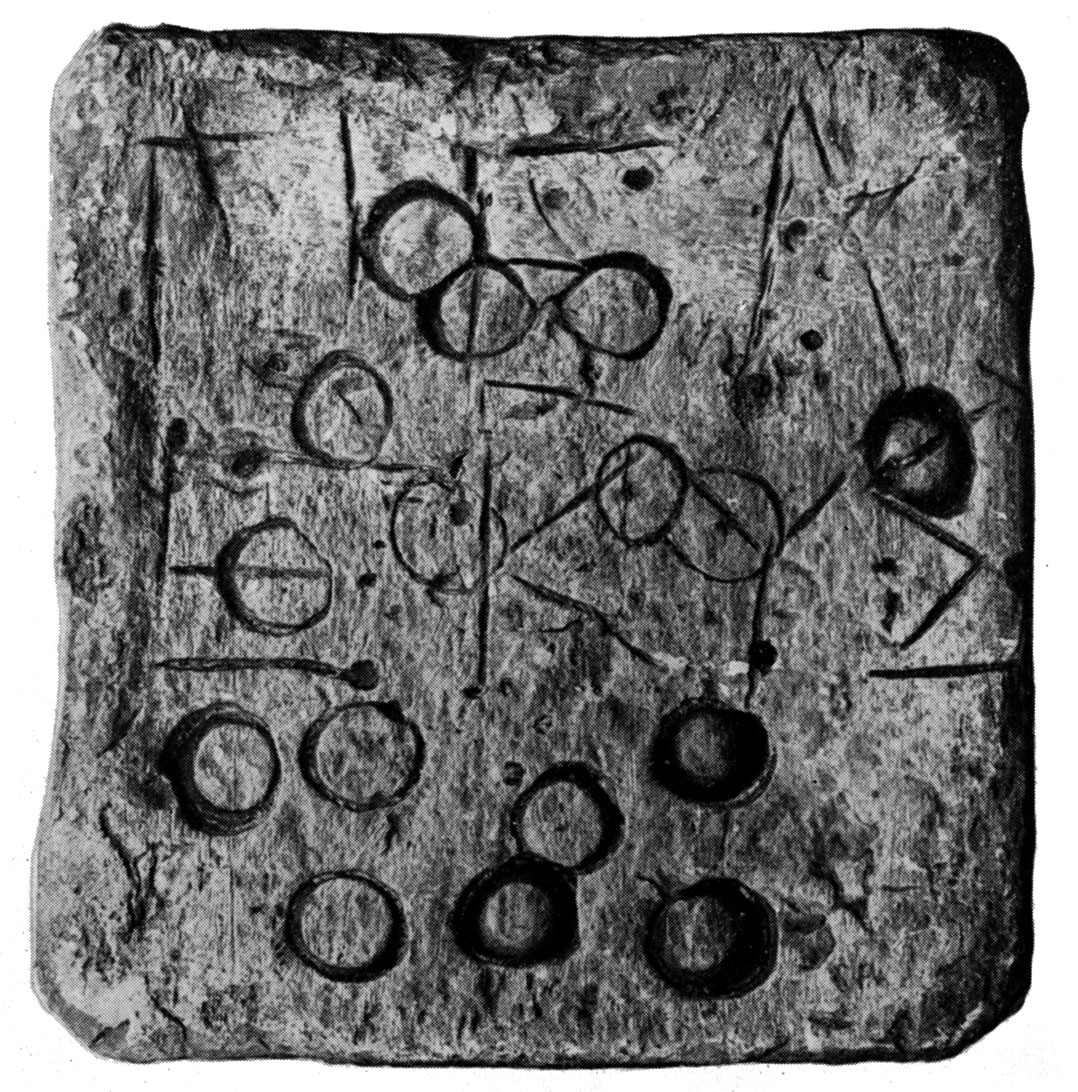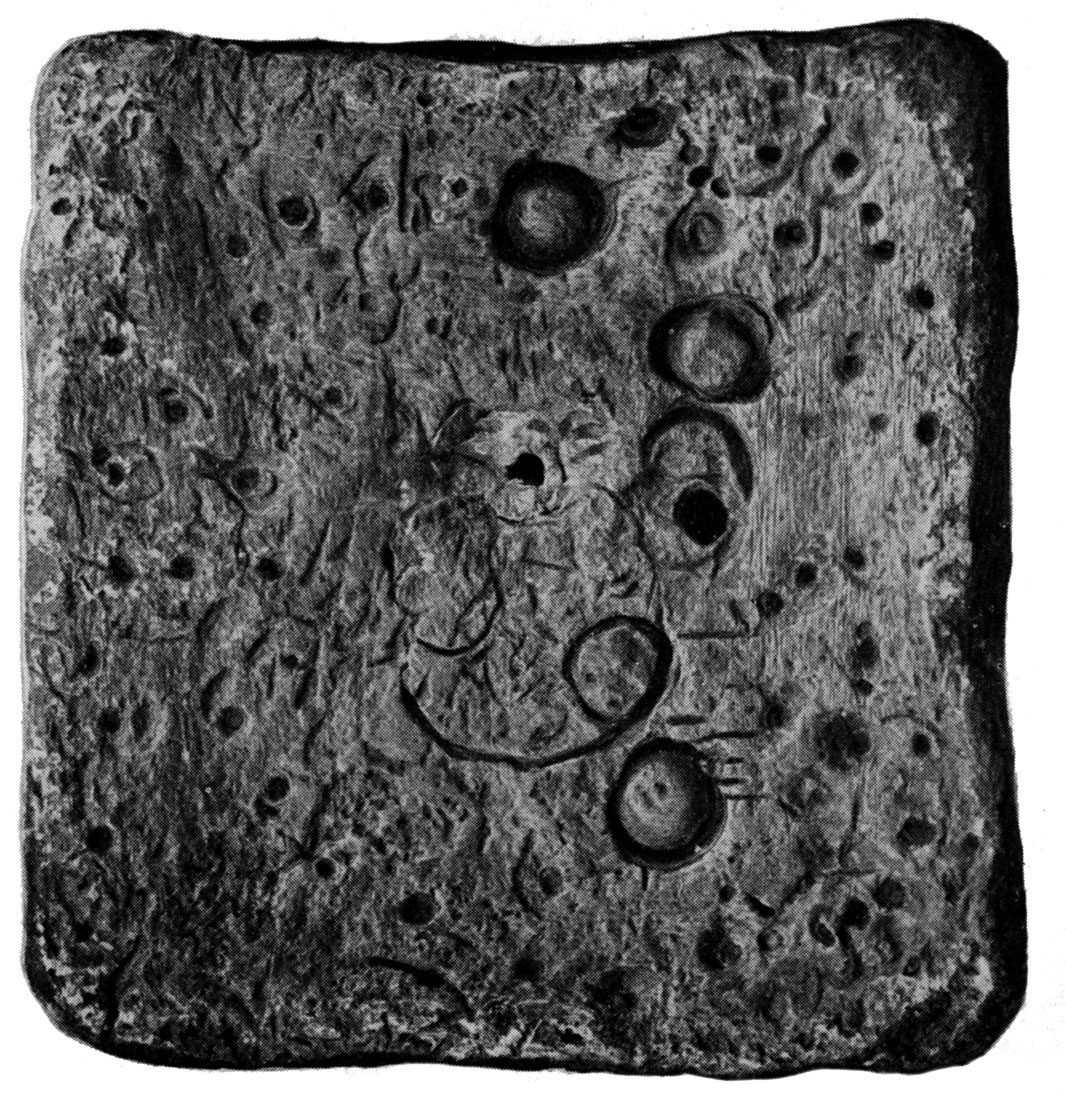
-
Copyright credit: Robinson 1941

-
Copyright credit: Robinson 1941

-
Copyright credit: BibleLandPictures.com

ARCHAEOLOGICAL DESCRIPTION OF THE WEIGHT
Authority
Mint
Denomination
1 Stater
,
3 Minas
Material
Lead
Manufacture
Cast
Shape
Square
Length
8.20 cm
Width
8.40 cm
Height
2.00 cm
Metrology
| Mass (g) | Mass (grain) | Date of measurement | Reference | fragmented | cleaned | reference weight |
|---|---|---|---|---|---|---|
| 1302.50 | - | - | Robinson 1941 | No | No | Yes |
| 1303.00 | - | April 19, 2018 | L. Delanaye | No | No | No |
Iconography
| Symbol | Technique | Direction | Position | Number | Synecdoche |
|---|---|---|---|---|---|
| Circle |
Wear
Little to no wear
Corrosion
Corroded
Handle
No
Suspension hole
No
Recarved mould
No
Recarved weight
No
Intentionally destroyed
No
Archaeological description
Square lead weight measuring 82x84x20 mm and weighing 1303 grammes, with slightly rounded corners ; little worn and corroded. On the obverse, many hollow rings ; incised letters ΠΕΛ | ΕΚΥΣ. Little hole under K and under Y. On the reverse, five engraved rings, two holes, little strokes. Many strokes, notches and bumps on the sides.
Robinson 1941: Approximately square. Top and bottom and one side slightly concave. Both top (obverse) and bottom (reverse) are pitted with circular cuttings averaging ca. 0.01 m. in diameter and of varying depths. Some may have been made with a tubular drill. The top has an inscription carelessly scratched before the circles were made. The letters are 0.018-0.022 m. in height.
ΠΕΛ
ΕΚΥΣ
The weight is 1302.5 grammes and might correspond to the Attic stater, since no. 2007 in the Athenian Archaeological Collection, which has a representation of the Macedonian god, Dionysus, and an astragalus in relief, bears the inscription στατήρ and weighs 1301.55 grammes. But other staters weigh only 810 to 924 grammes and another in Athens cited by Pernice weighs as much as 1422.5 grammes. There evidently is much variation from the norm, whether it be the heavier Aeginetan or early Solonian mina or the later lighter mina of half weight. The main interest of this Olynthian weight is the inscription πέλεκυς which is probably a survival from the time when bronze axes were used as barter or currency. In Homer for example, ten axes are given as a first prize. Coins of Tenedos have the axe symbol, which may represent the local unit of an earlier epoch, as Ridgeway says. Svoronos interpreted as numismatic axes certain copper ingots from Crete, Mycenae, and Euboean Cyme, but Seltman argued that these were hides. Perhaps the word πέλεκυς survived at Olynthus as the designation of a certain weight or stater, probably equivalent to three minas. In a fifth-century inscription from Cyprus the word πε(λέκερας) occurs several times with the meaning of ten minas and Hesychius, s. v. ἡμιπέλεκκον, says: τὸ γὰρ δεκάμνουν πέλεκυ καλεῖται παρὰ Παφίοις.
Robinson 1941: Approximately square. Top and bottom and one side slightly concave. Both top (obverse) and bottom (reverse) are pitted with circular cuttings averaging ca. 0.01 m. in diameter and of varying depths. Some may have been made with a tubular drill. The top has an inscription carelessly scratched before the circles were made. The letters are 0.018-0.022 m. in height.
ΠΕΛ
ΕΚΥΣ
The weight is 1302.5 grammes and might correspond to the Attic stater, since no. 2007 in the Athenian Archaeological Collection, which has a representation of the Macedonian god, Dionysus, and an astragalus in relief, bears the inscription στατήρ and weighs 1301.55 grammes. But other staters weigh only 810 to 924 grammes and another in Athens cited by Pernice weighs as much as 1422.5 grammes. There evidently is much variation from the norm, whether it be the heavier Aeginetan or early Solonian mina or the later lighter mina of half weight. The main interest of this Olynthian weight is the inscription πέλεκυς which is probably a survival from the time when bronze axes were used as barter or currency. In Homer for example, ten axes are given as a first prize. Coins of Tenedos have the axe symbol, which may represent the local unit of an earlier epoch, as Ridgeway says. Svoronos interpreted as numismatic axes certain copper ingots from Crete, Mycenae, and Euboean Cyme, but Seltman argued that these were hides. Perhaps the word πέλεκυς survived at Olynthus as the designation of a certain weight or stater, probably equivalent to three minas. In a fifth-century inscription from Cyprus the word πε(λέκερας) occurs several times with the meaning of ten minas and Hesychius, s. v. ἡμιπέλεκκον, says: τὸ γὰρ δεκάμνουν πέλεκυ καλεῖται παρὰ Παφίοις.
Autopsy
Yes
INSCRIPTION
| Language | Technique | Legend type |
|---|---|---|
| Greek | Incised | Denomination |
Fac simile
ΠΕΛ | ΕΚΥΣ
Edition
Πέλεκυς.
Monogram
ARCHAEOLOGICAL CONTEXT
Findspot (region)
Greece: Chalkidiki
Findspot (site)
Olynthus
context
Robinson 1941: From a Trial Trench in Section T, on the East Spur Hill, north of the House of the Comedian.
CIRCUMSTANCES OF ACQUISITION
Region
City
Date of first acquisition
circumstances
DATING OF THE WEIGHT
Curatorial Section
GREEK
Time frame
FROM
-500
TO
-350
Comments on Chronology
Robinson 1941: Fifth or early fourth century B. C.
COLLECTION HISTORY
Collection
| Name | Date of acquisition | Inventory number |
|---|---|---|
| Numismatic Museum (Athens) - Olynthos | None | 31.285/R_2382 |
Bibliography
| Reference | Page/Column | Reference (number) | Plate / Figure | Comment |
|---|---|---|---|---|
| Robinson 1941 | 447–449 | 2382 | CXXXVIII | None |
VARIA